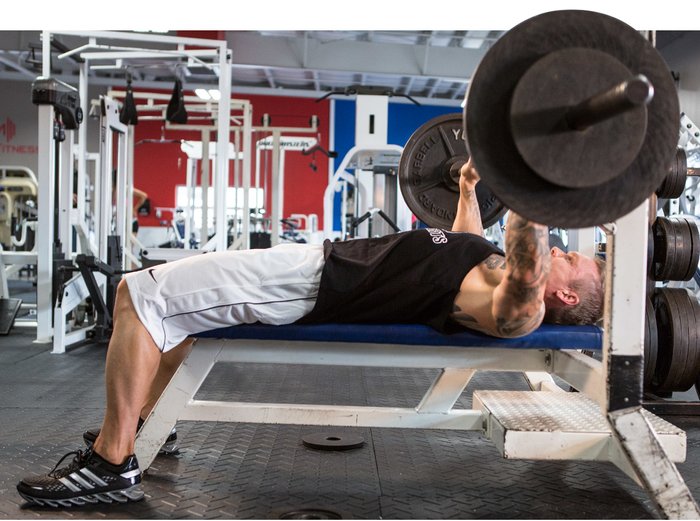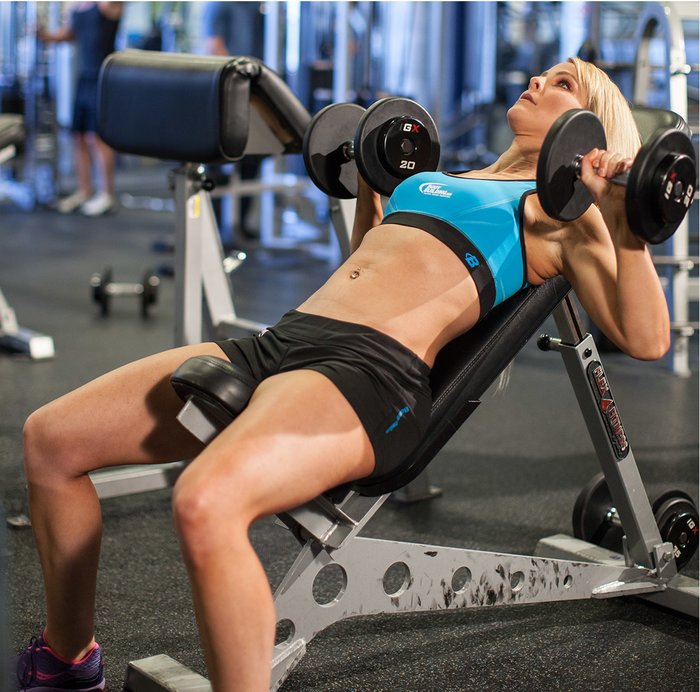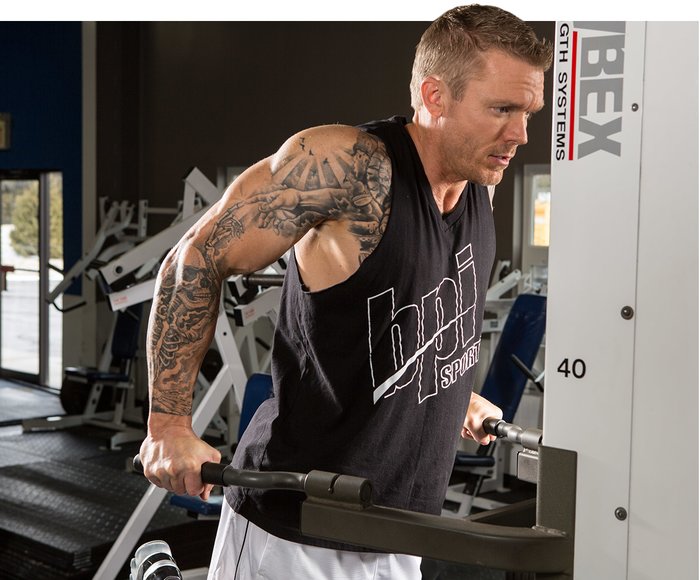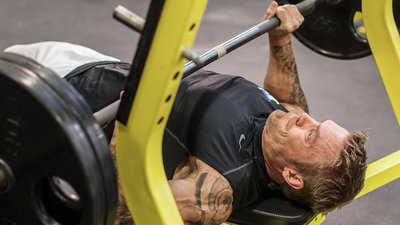It's time to go beyond the basics with training advice that people aren't talking about. These are the tips that fly like a stealth bomber—extremely effective, but well under the radar.
After you learn five of these best chest tips in the biz, apply them to each and every workout!
1. Retract Your Shoulders, Open Your Chest
Benching is a pretty simple motion: Lower the bar to your chest, and push it back up. While that seems pretty straightforward, there's actually a lot you can improve, like the position of your shoulder blades.
As you lower a barbell going into the stretch phase of a bench press, consciously retract your shoulder blades to swell out your chest like a big rooster. Try watching yourself in the mirror on a seated chest-press machine, or better yet, observe an experienced powerlifter; he'll have a big stretch, a slight overexaggeration in the thoracic spine, and a chest that puffs out.

"[When you don't squeeze] your shoulder blades, your shoulders will be in front of your chest, placing a heavier load on the front delts," says Bodybuilding.com science editor Krissy Kendall, PhD, CSCS. "With the scapula retracted [as you lower the bar], the sternum elevates, ultimately shortening the path the bar travels. This helps to recruit the lats and creates a stronger, safer press."
Kendall notes that the shortened bar path isn't a bad thing or a "cheat." In fact, it increases the work for your chest by putting more of the load on your pecs while taking it off the delts.
Bottom Line: Dig your shoulder blades into the bench when you press. You'll be better able to generate force through your pecs—and protect your shoulders—when you're safely stabilized on the bench.
2. Use Multiple Bench Angles
The main benefit of doing incline presses in additional to flat bench presses is that you can target the upper pecs more thoroughly. Likewise, you can add declines for the lower pecs.
But which of the training gods decreed there were only three bench angles? Intermediate bench angles—say, halfway between a flat and incline press—also present opportunities for muscle growth that are just different enough from the staples you're already using.

To try this out, set your adjustable bench to a flat position, and then move it up one notch. Have you ever trained at this slightly inclined angle? What if you take it up another notch, or even slightly higher than your normal incline position?
The steeper you set your bench, the higher up on your chest the point of maximal stimulation becomes—at the expense, of course, of also dialing up delt recruitment.
Bottom Line: To maximize chest growth, don't limit yourself to just the three bench angles, whether you're doing presses or flyes.

3. Focus on Your Liftoff and Lockout
Let's say you're stuck at 245 pounds for 6 reps on the bench press, and you can't seem to get over the hump no how many intensity techniques or assistance exercises you load into your workout. You're just plain stuck. Instead of drastically changing your routine, approach the problem like a powerlifter.
A powerlifter would try to improve the weakest spot in his bench-press range of motion (ROM), or where the sticking point occurs. Is it in the push off your chest at the bottom, in the lockout at the top, or somewhere in between? The answer determines the training strategies you'll use.
Building Strength At The Bottom
If you have trouble at the lower end of the ROM, bouncing the bar off your chest won't help, because you're just making the movement easier at that point. Instead, consider a method called paused bench presses (sometimes called dead benches), where you allow the bar to settle on the safeties in a power rack just off your chest for a 2-second count before powering out of the hole.
Normally, you reverse direction all in one motion, which enables built-up elastic energy to assist. But if you stop by allowing the bar to settle on the safeties in a power rack, that built-up energy disperses. You've now made the movement harder, and your short-term training strategy is to build up your strength over this arc of the ROM.
"The bar must settle on the safeties between each rep," says strength coach Josh Bryant, MS, CSCS. "You won't be able to lift as much weight this way because of the absence of elastic energy ... [but] you'll develop tremendous starting strength at the bottom of each rep."
Building Strength At The Top
If you have weakness in your lockout, you can make the bench slightly shallower. Using bench-press boards or repositioning the safeties in the power rack, train over a smaller portion of the ROM, perhaps just the top third.

Board press
You'll be able to use more weight than you normally would for full-range reps—the bench press follows an ascending strength curve, meaning you're stronger the farther the bar is from your chest—and therefore be able to really overload the movement and train your nervous system to handle more weight.
Building Strength Along Your Natural Strength Curve
Bench with bands or chains, which increase the load the farther the bar is from your chest. This more closely follows your own ascending strength curve and helps you build strength throughout the movement.
Bottom Line: Take a page out of the powerlifter's playbook and build strength on your bench press by attacking specific points along the range of motion. Strengthening various portions of the ROM will boost your bench overall, which can help you increase your loads on other chest movements.

4. Goose Your Triceps Training
You're probably aware of the role your triceps play in chest-pressing motions, especially toward the lockout phase, when your arms fully straighten. If your triceps are weak, they may end up fatiguing before your chest and becoming a weak link in your chest training overall, limiting your development.
Dedicated triceps work should be aimed at strengthening your arms rather than just pumping them up. This requires a more aggressive approach to arm work, including a reliance on multijoint exercises like weighted dips, machine dips, weighted bench dips, and close-grip bench presses; doing some sets for a slightly lower rep range better suited for strength gains; and including advanced techniques like the lockout exercises described above with a movement like close-grip benches. If you take a pedestrian 3-sets-of-10 approach and expect triceps push-downs to do the trick, you're going to fall short.
Remember to follow a training split in which your triceps are well rested by chest day. Avoid a split in which you train triceps (or delts, for that matter) immediately before your chest session.
Bottom Line: Focus on movements and techniques that can help you strengthen your triceps, which will also be an asset on chest-training days. A nice side pay-off is that you'll be able to handle more weight on triceps exercises, meaning you're boosting potential for some serious arm growth.
5. Follow a Dedicated Bench Program
Too many bodybuilders follow a somewhat random training approach: Even though they stick to a split, their chest day might consist of simply training as hard as possible on each and every exercise so long as they train in a muscle-building rep range, usually 8-12. That works for a while, but eventually trails off. Training even harder isn't the answer; training smarter is.

The solution here, again, is to rely on a system powerlifters and even Olympic weightlifters use: planned phases of progression that correspond with time, such as 10-12 weeks.
"Periodization, or planned variation in training volume and intensity, is extremely important for continued gains in strength," says Kendall. "By altering training conditions, you change muscle-fiber recruitment patterns to produce continued strength and hypertrophy."
By following a smart, pre-planned program on chest day, you can add as much as 20 percent more weight to your maximum bench press. Such a periodized approach often includes twice-a-week chest workouts, variations of wide- and close-grip benches in addition to regular ones, systematic alterations in the weight-and-rep schemes, and scheduled back-off periods for recovery. Most of all, you don't simply hit the bench and train as hard as you can every chest workout.
Bottom Line: Building a bigger chest starts with substantially strengthening it. The best approach is a periodized one that manipulates volume and intensity (load) over time.



